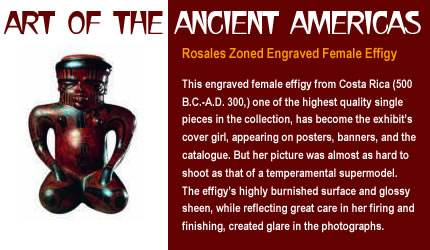Depictions
of humans and monkeys, birds and snakes, jaguars
and crocodiles weave their way through the new Art of
the Ancient Americas galleries at the Michael
C. Carlos Museum, transforming one to another like
a shared hallucinatory vision. The objects reveal composite
images–a bowl with elements of a stingray and a boa
constrictor; a goblet with a human head and feline fangs–that
capture many layers of self and embody a unity of nature
and all creatures.
To
fully experience this ancient art, says faculty curator
Rebecca Stone-Miller, a modern observer must let go of
rigid Western categories and presumptions and, as Proust
urged, “see with new eyes.”
Clear
distinctions between humans and animals are obliterated
in the exhibit, “which displaces the human from a
central position . . . [and] reverses a Western assumption
that animals and plants lie beneath the human in the cosmic
scheme,” says Stone-Miller, associate professor of
art history.
The
Art of the Ancient Americas galleries, which opened in
September 2002 after more than a year of renovations under
the direction of architect Michael Graves, houses one
of the most important collections of such art in the Southeast
and one of the key collections of art from ancient Costa
Rica in the country.

The
exhibit displays more than five hundred of the museum’s
nearly 2,200 works from ancient Mexico, Honduras, Nicaragua,
Costa Rica, Panama, Colombia, Ecuador, and Peru. Crafted
from clay, stone, metal, wood, fiber, bone, and shell,
the pieces reflect the belief systems and lifestyles of
the Maya, Aztec, Inca, and other ancient American cultures.
About
one-fourth of the objects, which include effigies, jewelry,
ritual artifacts, vessels, and textiles, have never been
displayed before.
Part
of preparing the exhibit involved identifying the animals
depicted on the objects. This often proved trickier than
it might seem, given that many animals were in dual or
transforming states. An image of a toad with ears, for
example, must have been achieved by blending in characteristics
of a human or other animal, since toads don’t have
ears.
A
person might even be combined with a plant, as evidenced
by a South American stirrup spout vessel showing a round-bodied
musician/peanut playing a flute. “The unity of person
and peanut is neither humorous nor trivial, but represents
. . . [that] the plant and the person are inexorably linked,”
says Stone-Miller. “More colloquially, ‘You
are what you eat.’ ”

A
good amount of detective work was involved in determining
the meaning or use of the pieces. For example, outlines
of a textile print on a South American female effigy tells
that the effigy was dressed, just as a real person would
have been; wear on the surface of an oval ceremonial grinding
platform from Costa Rica shows that the stone grinding
platform was actually used before burial; and yellow-brown
swabbed residue inside a watering vessel indicates that,
rather than water, maize beer was poured through the device.
Emory
scientists in related fields contributed their expertise
as well. Associate Professor of Environmental Studies
William B. Size conducted a groundbreaking geological
analysis of greenstones (“jades”) for the catalogue;
William Casarella, chair of Emory Hospital’s Radiology
Department, assisted in X-raying various ceramic pieces;
and Robert Wirtz, of the Centers for Disease Control and
Prevention, helped interpret a vessel depicting a survivor
of leishmaniasis–a disfiguring disease caused by
a parasite carried by animals, including rats and dogs,
and transferred to humans by the sandfly.
The
museum’s emphasis on acquiring art from the ancient
Americas began in 1988 with pieces from the collection
of Atlantans William C. and Carol W. Thibadeau.
William
Thibadeau, who died in November 2002 at eighty-two, donated
seven hundred pieces and sold the museum another six hundred
at a bargain price. Valued at $1 million in 1992 and now
worth three times that, the collection comprises an “interesting,
wide-ranging, and idiosyncratic grouping of works,”
says Stone-Miller, and was the impetus behind the museum’s
1993 expansion.
“So
many works of such quality,” says President William
M. Chace, “deserved to be seen in spacious and handsome
galleries.”–M.J.L.